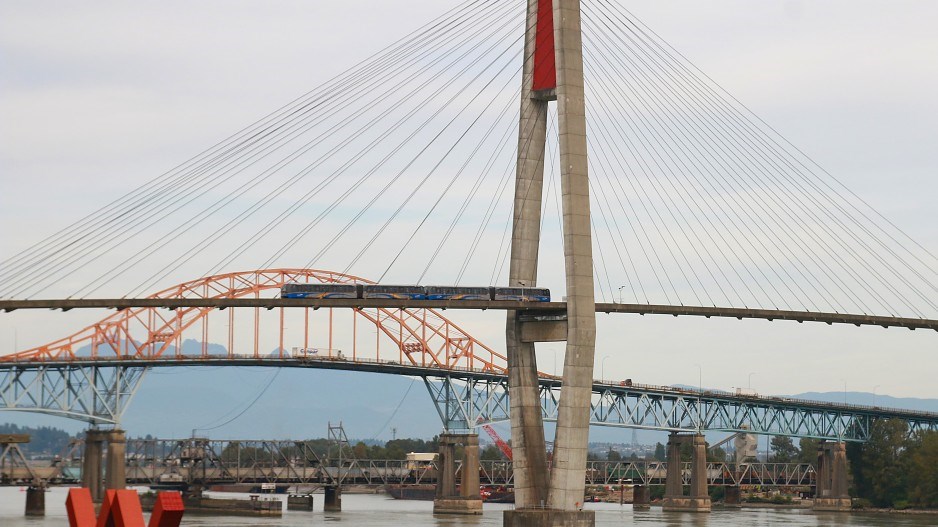Update: On Monday, the Supreme Court of British Columbia rejected a court challenge brought by industry against the province and its Community Benefits Agreement (CBA). The court ruled that it was not the appropriate forum for a Charter challenge. Those bringing the case forward have made the argument that the CBA's unionization requirement violates workers' Charter freedom of association. A court ruled last year that such a Charter challenge should be heard by the BC Labour Relations Board.
Below is Business in Vancouver's original story about the CBA court challenge and the framework that will influence work on some of B.C.'s biggest infrastructure projects.
This week, the Supreme Court of British Columbia will hear arguments on whether B.C.’s framework for ensuring local hiring, priority hiring and apprenticeship training on certain public-sector infrastructure projects is a reasonable exercise of provincial authority.
“No one’s saying these aren’t desirable and admirable outcomes that everyone supports. They are,” Independent Contractors and Businesses Association (ICBA) president Chris Gardner told Business in Vancouver. His organization is leading the petition against the province.
“The challenge here is that the Community Benefits Agreement (CBA) was really negotiated in back rooms with 19 building trades unions,” he said. “We want to impress upon the court that it’s unfair, it’s discriminatory, workers are going to lose out, contractors are losing out and taxpayers are going to pay more.”
The ICBA is supported in its action by 18 petitioners, which include construction companies, related associations, open-shop unions and individuals. Their argument, according to court documents, will be that the provincial government has given building trades unions a monopoly over employment opportunities on CBA projects by requiring all workers on a CBA project to join one of 19 unions, the majority of which are represented by or affiliated with BC Building Trades.
The court challenge claims the unionization requirement is mandated “for no legitimate or valid purpose.” Petitioners would like to see the requirement scrapped from existing CBA projects and would like an order prohibiting government from imposing the requirement on new ones.
The province did not directly answer BIV’s questions about how it selected the 19 unions workers must join in order to work on the Trans-Canada Highway expansion in Illecillewaet or on the replacement of the Pattullo Bridge.
Minister of Finance Carole James did provide a statement about the benefits of the CBA.
“This agreement makes sure people traditionally underrepresented in the trades and apprentices benefit through competitive, equal and transparent wages and skills development,” she wrote.

BC Building Trades (BCBT) executive director Andrew Mercier pointed to the training and equity-hiring track records of BCBT unions as evidence that models to train more apprentices and diversify hiring exist, and that BCBT unions are well positioned to deliver on the province’s desired outcomes.
“I think the proof is in the pudding,” he said. From 2016 to 2018, BCBT unions saw on average just over 700 Red Seal completions. Mercier said the unions have around 7,000 apprentices and trainees in the system now and spend $21.4 million a year on training.
The ICBA, Vancouver Regional Construction Association and other industry groups have argued that industry is also equipped to provide training, and that a pressing skilled labour shortage has many companies focused on and investing in developing their talent pipelines.
“There is nothing controversial about community benefit agreements,” said Mercier. All 19 unions listed under the CBA are represented by the Allied Infrastructure and Related Construction Council of British Columbia (AIRCC), which – along with the Ministry of Transportation and Infrastructure and the Attorney General of British Columbia – is a respondent to the challenge.
Any controversy, Mercier said, is the result of that litigation process.
“It’s a very middle-of-the-road policy option that’s been used by governments of all stripes across Canada, from Wacky [W.A.C.] Bennett to Gordon Campbell and everyone in between.”
Community benefits agreements, also referred to as project labour agreements, have been applied to projects across North America and were implemented on a number of major public works projects throughout B.C.’s history, including the W.A.C. Bennett Dam in the 1960s and the Vancouver Island Highway project in the 1990s.
The latter was the first major construction project in B.C. to include equity hiring and training measures for women, and the first time equity measures formed part of a project agreement on a highway project in Canada, according to a 2000 study by the Canadian Centre for Policy Alternatives (CCPA).
At the time, B.C. women accounted for less than 1% of construction trades, as did Indigenous people. However, workers from both groups together made up more than 22% of the workforce during peak Vancouver Island Highway building periods, according to the CCPA. The report’s authors noted that equity efforts were “stunningly successful” in part because hiring was centralized under Highway Constructors Ltd. (HCL), a government entity not unlike BC Infrastructure Benefits Inc. (BCIB), a Crown corporation created in 2018 to implement B.C.’s newest CBA.
Scott Jacob, president and CEO of Jacob Bros. Construction, spent a decade working with an open-shop contractor on Vancouver Island Highway work prior to founding his company. While HCL may have made gains on the equity front, he said the challenges from an industry perspective were untenable.
“The things I saw and the experiences I had have poisoned my life forever for this kind of legislation,” said Jacob. His company is one of the petitioners in the CBA court challenge.
He said having no relationship with workers who were dispatched by unions was at times a productivity issue and a safety issue. HCL and the project labour agreement’s unionization requirement added levels of complexity and bureaucracy that were difficult to navigate. In some cases, wages for trades were well above market rates, which affected work on other projects. Labour quality wasn’t necessarily predictable. Costs rose.
“I think it’s terrible policy, whether it’s building trades unions that benefit from this kind of legislation or whether it’s open shop or non-union, it would be equally wrong,” said Jacob. He told BIV that his company – which has worked on projects with the Vancouver International Airport, BC Hydro and various levels of government – will not be bidding on work subject to the CBA.
As for other contractors, the ICBA believes that its members will likely increase their costs in response to the labour uncertainty introduced by not being able to hire their preferred personnel on a project, and not knowing what working with the BCIB might require in terms of time and resources.
Mercier sees the CBA as a tool that ultimately introduces greater stability and predictability to major projects. Strikes and lockouts are not a possibility under the CBA, for example. The agreement also sets out clear policies for wages and hiring.
How the CBA works
With a budget of $8 million a year and a current staff count of 32, BCIB is responsible for implementing the province’s community benefits framework.
It operates as the employer on a CBA project, while labour is supplied by the 19 unions represented collectively by the AIRCC, which functions as the unions’ bargaining agent. The CBA itself is a more than 330-page document that outlines in detail the agreement made between the project employer and the AIRCC, whose members will supply the employer with labour.
Contractors who successfully bid on and win CBA contracts have the opportunity to name-hire workers, as laid out in the CBA. Workers become employees of BCIB, and all employees must join an AIRCC union. There is no requirement for an individual employed with a contractor to terminate his or her employment on becoming an employee with BCIB, according to the Crown corporation, though employers and contractors have voiced concerns about how employment will work in practice.
In addition to establishing wages and other employment terms, the CBA sets out a hiring framework that the province maintains will ensure apprentices get trained, job opportunities go to local workers and equity hires – including women and Indigenous people – are prioritized.
The highway expansion at Illecillewaet is the first infrastructure project to fall under the CBA and BCIB’s authority. Thirty-three workers are involved, with 28% of project hours going to local hires, 24% to female workers and 11% to Indigenous workers. The project has no apprentices given the nature of the trades involved, but eight trainees have put in time on the project. The CBA’s target ratio of apprenticeship hours to journeyperson hours is 25%.
Clarifying the CBA
In about a month, the BCIB is expected to deliver a services plan that details its priorities and efforts on education, recruitment, retention and workplace culture. The latter involves mandatory respectful-workplace training.
For firms and organizations impacted by the CBA, next steps involve better understanding the framework that will influence work on some of B.C.’s biggest public infrastructure projects.
“We’re playing catch-up a little bit and trying to figure our way through it,” said Ken McCormack, president and CEO of the Construction Labour Relations Association of BC, which represents employers of unionized labour on construction projects.
He said his association is really just beginning discussions with BCIB and is still looking to understand risks and liabilities associated with the projects. Members will bid on CBA projects if there is an opportunity, he said, but there remains some uncertainty about the specific operations of the BCIB.
“Until very recently, the employer community – which we represent – weren’t really included much in the discussions,” McCormack said. “In a province where we’re seeing significant growth in construction and there’s a lot of work out there, [our members are] weighing the options between these public infrastructure projects and other projects they’re bidding on.”
Todd Strynadka, past chair of the BC Road Builders & Heavy Construction Association, was asked to weigh in on community benefits agreements several years ago.
“It was not the most transparent process,” he said. He recalls an opportunity to discuss the CBA with Minister Claire Trevena alongside a number of contractors of varying sizes and various agreements with unions.
“It’s like we had a script, because we all said the same thing about this risk-sharing. It was a two-hour meeting, everyone said the same thing and the CBA still rolled out,” he said.
Strynadka noted that a top concern from industry was and remains how the agreement affects how companies and contractors evaluate risk, and what working with new workers employed by a Crown corporation might mean for a contractor’s operations and policies on everything from culture to safety.
New court challenge, familiar claims
This week’s court challenge is not the first time a Canadian community benefits agreement or project labour agreement has been legally challenged.
In 1994, the Christian Labour Association of Canada challenged the project labour agreement in place for construction of the Columbia River hydroelectric dam, arguing the requirement that workers join a building trades union constituted an unfair labour practice. The BC Labour Relations Board found that the requirement did not violate B.C.’s Labour Relations Code and dismissed the challenge.
The ICBA and the Christian Labour Association also challenged Highway Constructors Ltd.’s project labour agreement for the Vancouver Island Highway project, claiming that it violated workers’ freedom of association. The BC Labour Relations Board did not agree.
More recently in Manitoba, the Merit Contractors Association of Manitoba challenged the Manitoba Hydro-Electric Board’s tendering policy, which compelled contractors’ employees to join specific unions on certain projects. Merit’s appeal was dismissed in 2016 and the Supreme Court of Canada declined to hear the case in 2017.
At press time, the B.C. CBA court challenge is scheduled for five days in court beginning February 3.




